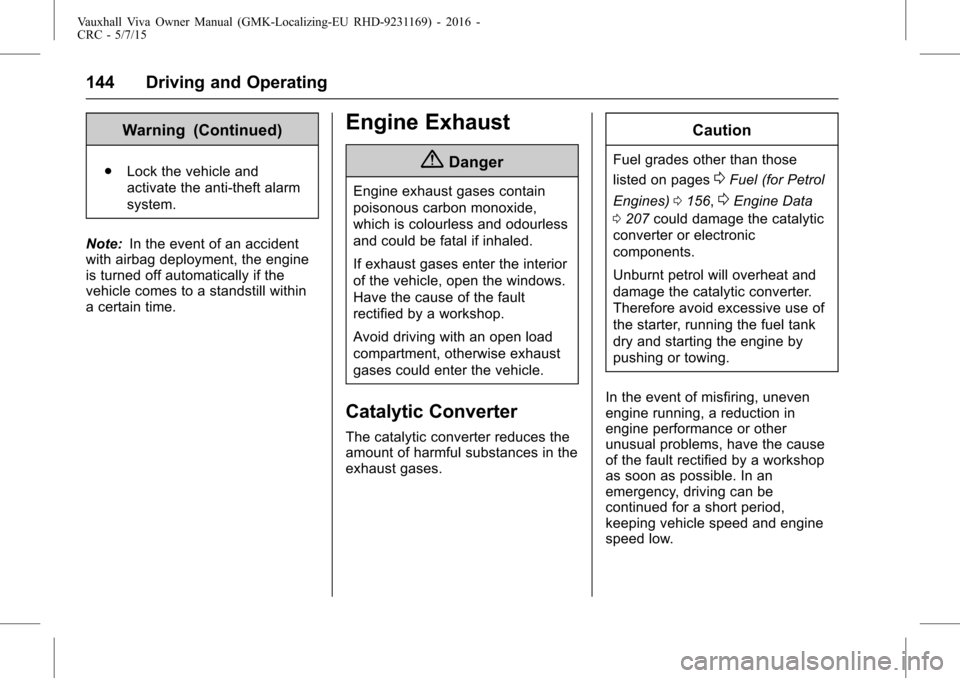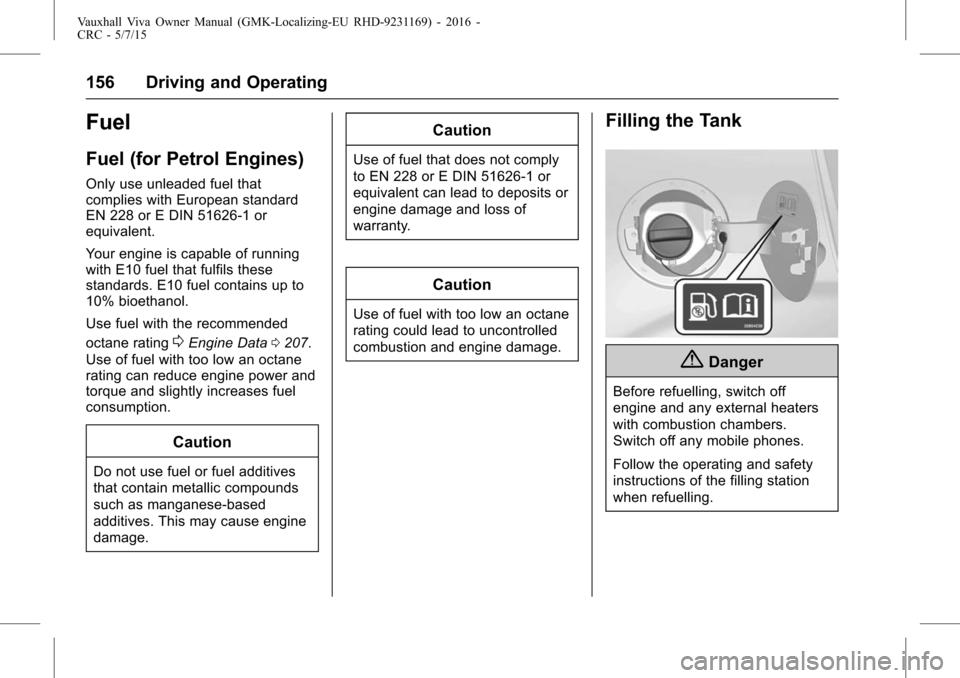2015.75 VAUXHALL VIVA fuel
[x] Cancel search: fuelPage 142 of 222

Vauxhall Viva Owner Manual (GMK-Localizing-EU RHD-9231169) - 2016 -
CRC - 5/7/15
Driving and Operating 141
Retained Accessory
Power (RAP)
Retained power off
The following electronic systems
can work until the driver's door is
opened or at the latest for
10 minutes after the ignition is
switched off :
.power windows
. power outlets
Power to the Infotainment system
will continue to operate for
30 minutes or until the key is
removed from the ignition,
regardless of whether any door will
be opened.
Automatic Engine Start/
Stop Feature
The stop-start system helps to save
fuel. When conditions allow, it
switches off the engine as soon as
the vehicle is at a low speed or at a
standstill, e.g. at a traffic light or in a
traffic jam. It starts the engine
automatically as soon as the clutch
is depressed. A vehicle battery sensor ensures that an Autostop is
only performed if the vehicle battery
is sufficiently charged for a restart.
Activation
The stop-start system is available
as soon as the engine is started, the
vehicle starts-off and the conditions
as stated below in this section are
fulfilled.
Deactivation
Deactivate the stop-start system
manually by pressing the button.
The deactivation is indicated by the
LED in the button extinguishing.
Autostop
If the vehicle is at a low speed or at
a standstill, activate an Autostop as
follows :
.
depress the clutch pedal
. set the lever in neutral
. release the clutch pedal
The engine will be switched off
while the ignition stays on.
An Autostop is indicated by the
needle at the AUTOSTOP position
in the tachometer.
Page 145 of 222

Vauxhall Viva Owner Manual (GMK-Localizing-EU RHD-9231169) - 2016 -
CRC - 5/7/15
144 Driving and Operating
Warning (Continued)
.Lock the vehicle and
activate the anti-theft alarm
system.
Note: In the event of an accident
with airbag deployment, the engine
is turned off automatically if the
vehicle comes to a standstill within
a certain time.
Engine Exhaust
{Danger
Engine exhaust gases contain
poisonous carbon monoxide,
which is colourless and odourless
and could be fatal if inhaled.
If exhaust gases enter the interior
of the vehicle, open the windows.
Have the cause of the fault
rectified by a workshop.
Avoid driving with an open load
compartment, otherwise exhaust
gases could enter the vehicle.
Catalytic Converter
The catalytic converter reduces the
amount of harmful substances in the
exhaust gases.
Caution
Fuel grades other than those
listed on pages
0Fuel (for Petrol
Engines) 0156,
0Engine Data
0 207 could damage the catalytic
converter or electronic
components.
Unburnt petrol will overheat and
damage the catalytic converter.
Therefore avoid excessive use of
the starter, running the fuel tank
dry and starting the engine by
pushing or towing.
In the event of misfiring, uneven
engine running, a reduction in
engine performance or other
unusual problems, have the cause
of the fault rectified by a workshop
as soon as possible. In an
emergency, driving can be
continued for a short period,
keeping vehicle speed and engine
speed low.
Page 157 of 222

Vauxhall Viva Owner Manual (GMK-Localizing-EU RHD-9231169) - 2016 -
CRC - 5/7/15
156 Driving and Operating
Fuel
Fuel (for Petrol Engines)
Only use unleaded fuel that
complies with European standard
EN 228 or E DIN 51626-1 or
equivalent.
Your engine is capable of running
with E10 fuel that fulfils these
standards. E10 fuel contains up to
10% bioethanol.
Use fuel with the recommended
octane rating
0Engine Data0207.
Use of fuel with too low an octane
rating can reduce engine power and
torque and slightly increases fuel
consumption.
Caution
Do not use fuel or fuel additives
that contain metallic compounds
such as manganese-based
additives. This may cause engine
damage.
Caution
Use of fuel that does not comply
to EN 228 or E DIN 51626-1 or
equivalent can lead to deposits or
engine damage and loss of
warranty.
Caution
Use of fuel with too low an octane
rating could lead to uncontrolled
combustion and engine damage.
Filling the Tank
{Danger
Before refuelling, switch off
engine and any external heaters
with combustion chambers.
Switch off any mobile phones.
Follow the operating and safety
instructions of the filling station
when refuelling.
Page 158 of 222

Vauxhall Viva Owner Manual (GMK-Localizing-EU RHD-9231169) - 2016 -
CRC - 5/7/15
Driving and Operating 157
{Danger
Fuel is flammable and explosive.
No smoking. No naked flames or
sparks.
If you can smell fuel in your
vehicle, have the cause of this
remedied immediately by a
workshop.
Caution
In case of misfuelling, do not
switch on ignition.
1. Stop the engine.
2. Pull up on fuel filler doorrelease lever located on the
floor, right front side of
driver's seat.
3. Turn the fuel filler cap anticlockwise slowly. If a
hissing sound is heard, wait for
it to stop before completely
unscrewing the cap. The fuel
filler door is in the right
rear quarter panel.4. Remove the cap. The cap istethered to the vehicle.
5. After refuelling, replace cap. Turn it clockwise until you hear
several clicks.
6. Push the fuel filler door closed until it latches.
Note: If, in cold weather, the fuel
filler door does not open, tap the
door lightly. Then try to open it
again.
Caution
Wipe off any overflowing fuel
immediately.
Page 159 of 222

Vauxhall Viva Owner Manual (GMK-Localizing-EU RHD-9231169) - 2016 -
CRC - 5/7/15
158 Driving and Operating
Fuel Consumption -
CO2-Emissions
The fuel consumption (combined) of
the model Opel Karl is within a
range of to 52 to 58 mpg.
The CO
2emission (combined) is
within a range of 104 to 99 g/km.
For the values specific for your
vehicle, refer to the EEC Certificate
of Conformity provided with your
vehicle or other national registration
documents.
General information
The official fuel consumption and
specific CO2emission figures
quoted relate to the EU base model
with standard equipment.
Fuel consumption data and CO
2
emission data are determined
according to regulation R (EC) No.
715/2007 (in the version
respectively applicable), taking into
consideration the vehicle weight in
running order, as specified by the
regulation. The figures are provided only for the
purpose of comparison between
different vehicle variants and must
not be taken as a guarantee for the
actual fuel consumption of a
particular vehicle. Additional
equipment may result in slightly
higher results than the stated
consumption and CO
2figures.
Furthermore, fuel consumption is
dependent on personal driving style
as well as road and traffic
conditions.
Page 161 of 222

Vauxhall Viva Owner Manual (GMK-Localizing-EU RHD-9231169) - 2016 -
CRC - 5/7/15
160 Vehicle Care
General Information
Accessories and
Modifications
We recommend the use of genuine
parts and accessories and factory
approved parts specific for your
vehicle type. We cannot assess or
guarantee reliability of other
products - even if they have a
regulatory or otherwise granted
approval.
Do not make any modifications to
the electrical system, e.g. changes
of electronic control units (chip
tuning).
Caution
When transporting the vehicle on
a train or on a recovery vehicle,
the mud flaps might be damaged.
Vehicle Storage
Storage for a long period
of time
If the vehicle is to be stored for
several months :
.Wash and wax the vehicle.
. Have the wax in the engine
compartment and underbody
checked.
. Clean and preserve the rubber
seals.
. Fill up fuel tank completely.
. Change the engine oil.
. Drain the washer fluid reservoir.
. Check the coolant antifreeze
and corrosion protection.
. Adjust tyre pressure to the value
specified for full load.
. Park the vehicle in a dry, well
ventilated place. Engage first or
reverse gear. Prevent the
vehicle from rolling.
. Do not apply the parking brake. .
Open the bonnet, close all doors
and lock the vehicle.
. Disconnect the clamp from the
negative terminal of the vehicle
battery. Beware that all systems
are not functional, e.g. anti-theft
alarm system.
Putting back into operation
When the vehicle is to be put back
into operation :
.Connect the clamp to the
negative terminal of the vehicle
battery. Activate the electronics
of the power windows.
. Check tyre pressure.
. Fill up the washer fluid reservoir.
. Check the engine oil level.
. Check the coolant level.
. Fit the number plate if
necessary.
Page 176 of 222

Vauxhall Viva Owner Manual (GMK-Localizing-EU RHD-9231169) - 2016 -
CRC - 5/7/15
Vehicle Care 175
3 Rear demist
4 Outside rear-view mirrorheater
5 Sunroof
6 Continuously Variable transmission control module
7 Mass air flow sensor
8 Auxiliary heater pump
9 Anti-lock brake system valve
10 Regulated voltage control 11 Rear view camera
12 -
13 -
14 Engine control module/ Transmission control
module
15 Fuel injection control module/Starter
16 Fuel pump motor
17 Engine control module1
18 Engine control module2
19 Injector, Ignition 20 Air conditioning system
21 Intelligent battery sensor
22 Electric steering
column lock
23 Cooling fan low
24 -
25 Outside rear-view mirror switch
26 Engine control module/ Automated manual gearbox
module
27 Canister vent solenoid
28 Brake pedal switch
29 Auxiliary occupant sensing
30 Headlight levelling motor
31 Horn
32 Front fog lamp
33 Main beam left
34 Main beam right
35 -
36 Rear wiper motor
37 Cornering lamp left 38 Washer pump motor
39 Cornering lamp right
40 -
41 -
42 Starter 2
43 In-panel bussed electric
centre
44 Automated manual gearbox
45 Starter 1
46 Anti-lock brake system pump
47 Cooling fan hi
48 Front wiper motor
49 In-panel bussed electric centre accessory/RAP
power
Page 180 of 222

Vauxhall Viva Owner Manual (GMK-Localizing-EU RHD-9231169) - 2016 -
CRC - 5/7/15
Vehicle Care 179
Directional tyres
Directional tyres must be mounted
so that they rotate in the correct
direction. The proper rotation
direction is indicated by a symbol
(e.g. an arrow) on the sidewall.
Tyre Pressure
Check the pressure of cold tyres at
least every 14 days and before any
long journey. Do not forget the
spare wheel. This also applies to
vehicles with tyre pressure
monitoring system.
Unscrew the valve cap.
Tyre pressure0Tyre
Pressure 0209.
The tyre pressure information label
on the left door frame indicates the
original equipment tyres and the
correspondent tyre pressures.
Always inflate the spare tyre to the
pressure specified for full load.
The ECO tyre pressure serves to
achieve the lowest fuel consumption
possible.
Incorrect tyre pressures will impair
safety, vehicle handling, comfort and
fuel economy and will increase
tyre wear.
Tyre pressures differ depending on
various options. For the correct tyre
pressure value, follow the procedure
below: 1. Identify the engine identifier code.
0Engine Data 0207.
2. Identify the respective tyre.
The tyre pressure tables show all
possible tyre combinations
0Tyre
Pressure 0209 For the tyres approved for your
vehicle, refer to the EEC Certificate
of Conformity provided with your
vehicle or other national registration
documents.
The driver is responsible for correct
adjustment of tyre pressure.
{Warning
If the pressure is too low, this can
result in considerable tyre
warmup and internal damage,
leading to tread separation and
even to tyre blow-out at high
speeds.
If the tyre pressure must be reduced
or increased on a vehicle with tyre
pressure monitoring system, switch
off ignition.
After adjusting tyre pressure switch
on ignition and select the according
setting on the page Tyre load in the
Driver Information Centre,
0Driver
Information Centre (DIC) 075.